Organisational Culture, Workforce Motivation and Team Dynamics Report
VerifiedAdded on 2020/10/22
|27
|8190
|217
Report
AI Summary
This report provides a comprehensive analysis of organisational culture, workforce motivation, and team dynamics. It delves into the impact of culture, power, and politics on individual behaviour and performance, examining different organisational culture types as per Handy's model, and their influence on employee behaviour. The report evaluates content and process theories of motivation, applying them to motivate the workforce, with Waitrose as a case study. Furthermore, it explores team dynamics, differentiating between effective and ineffective teams, and applying organisational behaviour concepts and philosophies to enhance team performance and overall organisational success. The report emphasizes the importance of creating a healthy work environment and using power effectively to boost employee morale and productivity.
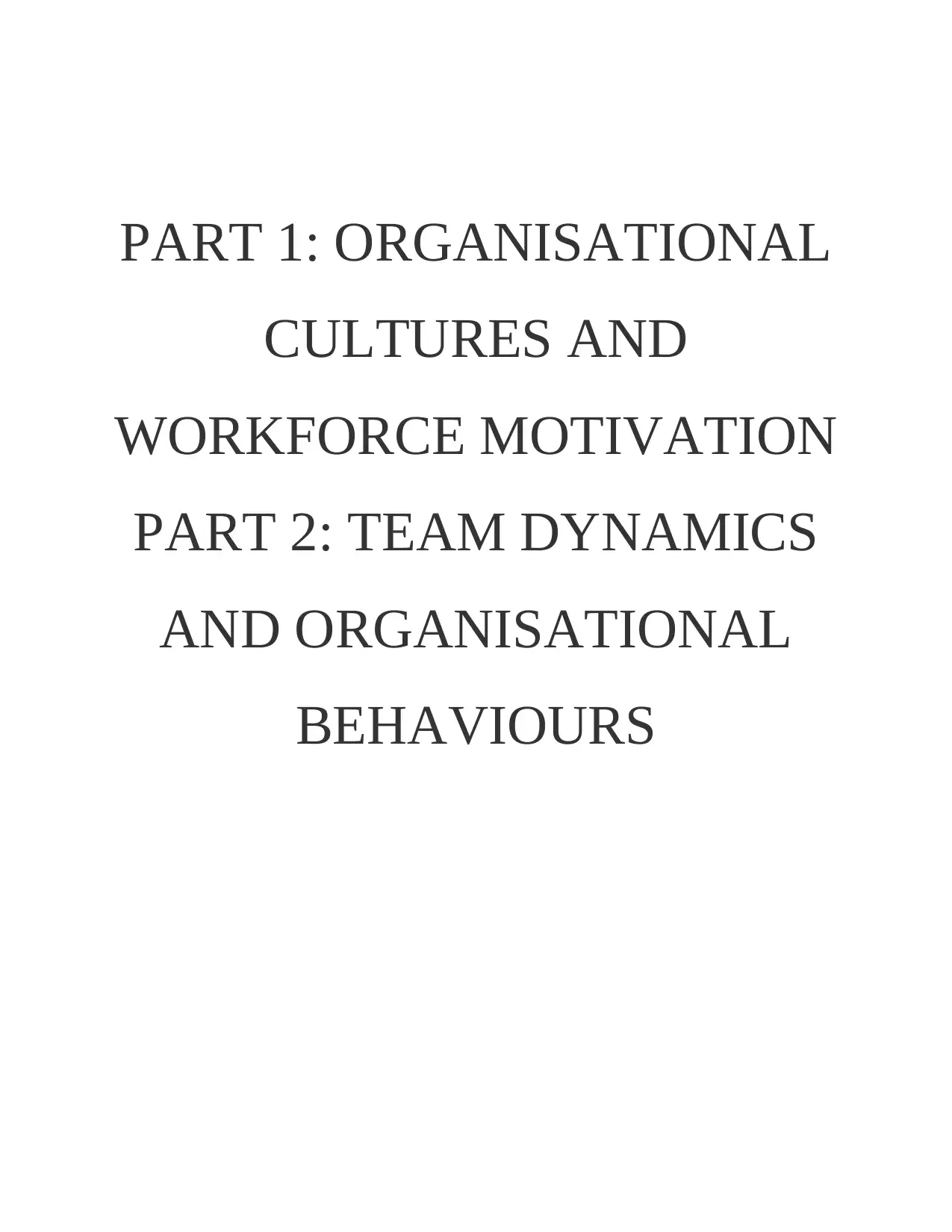
PART 1: ORGANISATIONAL
CULTURES AND
WORKFORCE MOTIVATION
PART 2: TEAM DYNAMICS
AND ORGANISATIONAL
BEHAVIOURS
CULTURES AND
WORKFORCE MOTIVATION
PART 2: TEAM DYNAMICS
AND ORGANISATIONAL
BEHAVIOURS
Paraphrase This Document
Need a fresh take? Get an instant paraphrase of this document with our AI Paraphraser
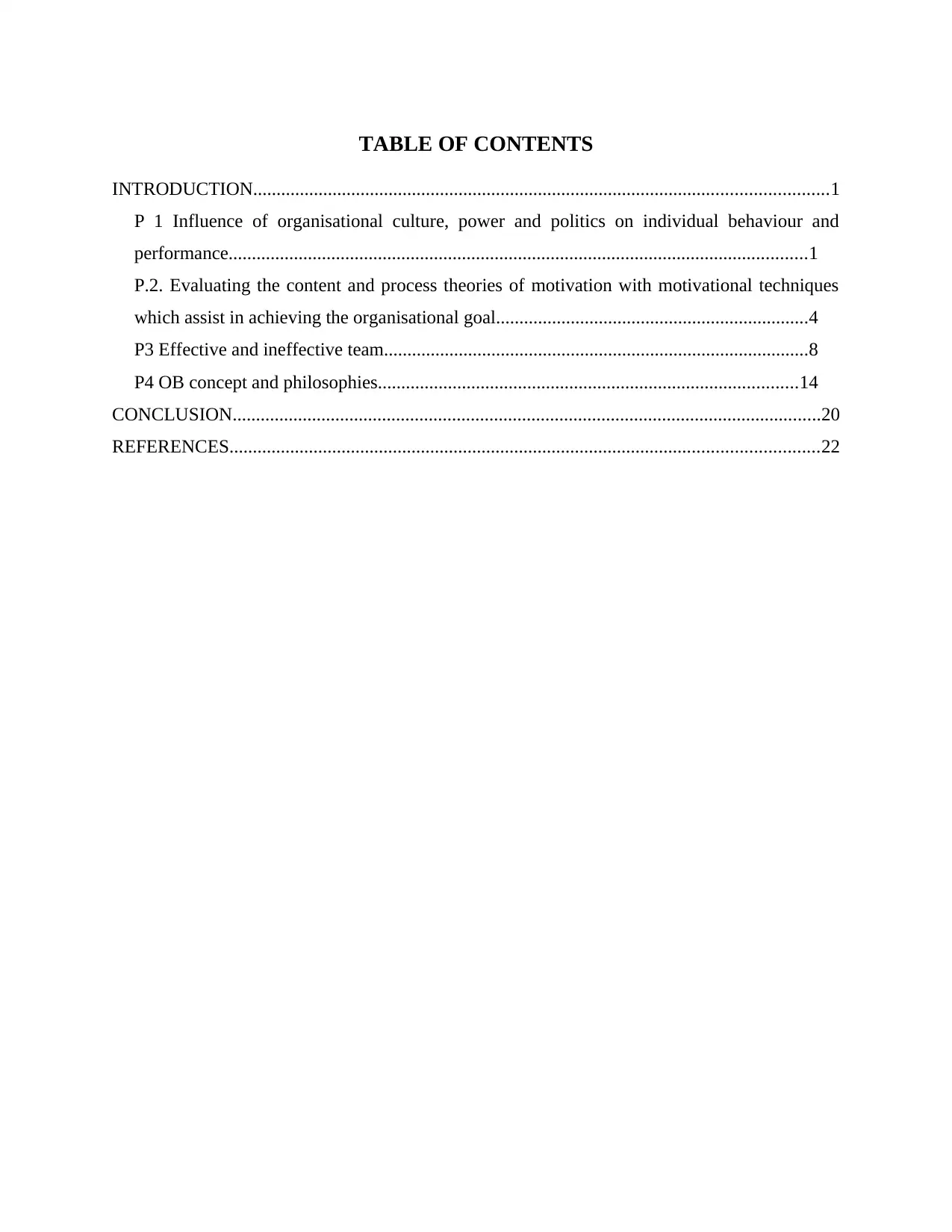
TABLE OF CONTENTS
INTRODUCTION...........................................................................................................................1
P 1 Influence of organisational culture, power and politics on individual behaviour and
performance............................................................................................................................1
P.2. Evaluating the content and process theories of motivation with motivational techniques
which assist in achieving the organisational goal...................................................................4
P3 Effective and ineffective team...........................................................................................8
P4 OB concept and philosophies..........................................................................................14
CONCLUSION..............................................................................................................................20
REFERENCES..............................................................................................................................22
INTRODUCTION...........................................................................................................................1
P 1 Influence of organisational culture, power and politics on individual behaviour and
performance............................................................................................................................1
P.2. Evaluating the content and process theories of motivation with motivational techniques
which assist in achieving the organisational goal...................................................................4
P3 Effective and ineffective team...........................................................................................8
P4 OB concept and philosophies..........................................................................................14
CONCLUSION..............................................................................................................................20
REFERENCES..............................................................................................................................22
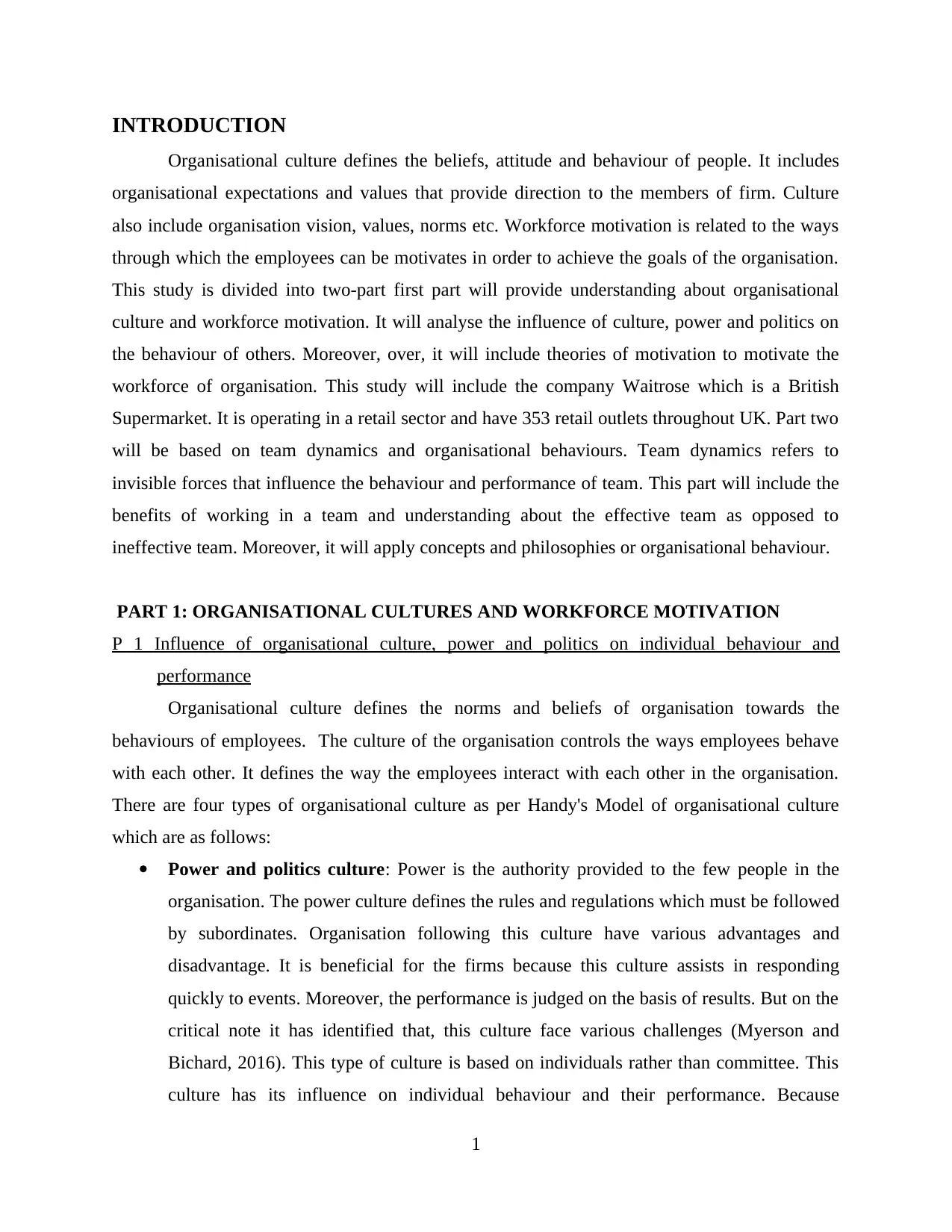
INTRODUCTION
Organisational culture defines the beliefs, attitude and behaviour of people. It includes
organisational expectations and values that provide direction to the members of firm. Culture
also include organisation vision, values, norms etc. Workforce motivation is related to the ways
through which the employees can be motivates in order to achieve the goals of the organisation.
This study is divided into two-part first part will provide understanding about organisational
culture and workforce motivation. It will analyse the influence of culture, power and politics on
the behaviour of others. Moreover, over, it will include theories of motivation to motivate the
workforce of organisation. This study will include the company Waitrose which is a British
Supermarket. It is operating in a retail sector and have 353 retail outlets throughout UK. Part two
will be based on team dynamics and organisational behaviours. Team dynamics refers to
invisible forces that influence the behaviour and performance of team. This part will include the
benefits of working in a team and understanding about the effective team as opposed to
ineffective team. Moreover, it will apply concepts and philosophies or organisational behaviour.
PART 1: ORGANISATIONAL CULTURES AND WORKFORCE MOTIVATION
P 1 Influence of organisational culture, power and politics on individual behaviour and
performance
Organisational culture defines the norms and beliefs of organisation towards the
behaviours of employees. The culture of the organisation controls the ways employees behave
with each other. It defines the way the employees interact with each other in the organisation.
There are four types of organisational culture as per Handy's Model of organisational culture
which are as follows:
Power and politics culture: Power is the authority provided to the few people in the
organisation. The power culture defines the rules and regulations which must be followed
by subordinates. Organisation following this culture have various advantages and
disadvantage. It is beneficial for the firms because this culture assists in responding
quickly to events. Moreover, the performance is judged on the basis of results. But on the
critical note it has identified that, this culture face various challenges (Myerson and
Bichard, 2016). This type of culture is based on individuals rather than committee. This
culture has its influence on individual behaviour and their performance. Because
1
Organisational culture defines the beliefs, attitude and behaviour of people. It includes
organisational expectations and values that provide direction to the members of firm. Culture
also include organisation vision, values, norms etc. Workforce motivation is related to the ways
through which the employees can be motivates in order to achieve the goals of the organisation.
This study is divided into two-part first part will provide understanding about organisational
culture and workforce motivation. It will analyse the influence of culture, power and politics on
the behaviour of others. Moreover, over, it will include theories of motivation to motivate the
workforce of organisation. This study will include the company Waitrose which is a British
Supermarket. It is operating in a retail sector and have 353 retail outlets throughout UK. Part two
will be based on team dynamics and organisational behaviours. Team dynamics refers to
invisible forces that influence the behaviour and performance of team. This part will include the
benefits of working in a team and understanding about the effective team as opposed to
ineffective team. Moreover, it will apply concepts and philosophies or organisational behaviour.
PART 1: ORGANISATIONAL CULTURES AND WORKFORCE MOTIVATION
P 1 Influence of organisational culture, power and politics on individual behaviour and
performance
Organisational culture defines the norms and beliefs of organisation towards the
behaviours of employees. The culture of the organisation controls the ways employees behave
with each other. It defines the way the employees interact with each other in the organisation.
There are four types of organisational culture as per Handy's Model of organisational culture
which are as follows:
Power and politics culture: Power is the authority provided to the few people in the
organisation. The power culture defines the rules and regulations which must be followed
by subordinates. Organisation following this culture have various advantages and
disadvantage. It is beneficial for the firms because this culture assists in responding
quickly to events. Moreover, the performance is judged on the basis of results. But on the
critical note it has identified that, this culture face various challenges (Myerson and
Bichard, 2016). This type of culture is based on individuals rather than committee. This
culture has its influence on individual behaviour and their performance. Because
1
⊘ This is a preview!⊘
Do you want full access?
Subscribe today to unlock all pages.

Trusted by 1+ million students worldwide
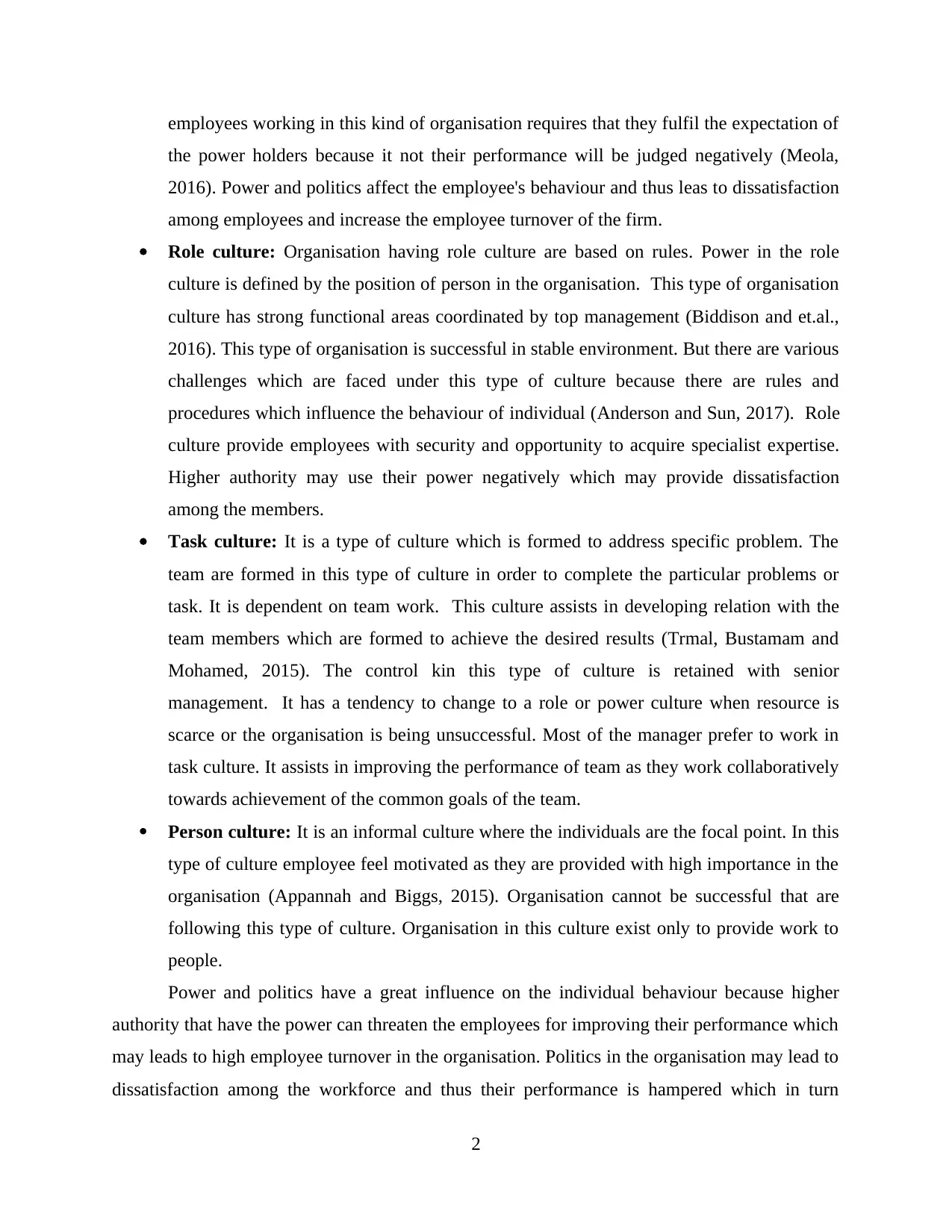
employees working in this kind of organisation requires that they fulfil the expectation of
the power holders because it not their performance will be judged negatively (Meola,
2016). Power and politics affect the employee's behaviour and thus leas to dissatisfaction
among employees and increase the employee turnover of the firm.
Role culture: Organisation having role culture are based on rules. Power in the role
culture is defined by the position of person in the organisation. This type of organisation
culture has strong functional areas coordinated by top management (Biddison and et.al.,
2016). This type of organisation is successful in stable environment. But there are various
challenges which are faced under this type of culture because there are rules and
procedures which influence the behaviour of individual (Anderson and Sun, 2017). Role
culture provide employees with security and opportunity to acquire specialist expertise.
Higher authority may use their power negatively which may provide dissatisfaction
among the members.
Task culture: It is a type of culture which is formed to address specific problem. The
team are formed in this type of culture in order to complete the particular problems or
task. It is dependent on team work. This culture assists in developing relation with the
team members which are formed to achieve the desired results (Trmal, Bustamam and
Mohamed, 2015). The control kin this type of culture is retained with senior
management. It has a tendency to change to a role or power culture when resource is
scarce or the organisation is being unsuccessful. Most of the manager prefer to work in
task culture. It assists in improving the performance of team as they work collaboratively
towards achievement of the common goals of the team.
Person culture: It is an informal culture where the individuals are the focal point. In this
type of culture employee feel motivated as they are provided with high importance in the
organisation (Appannah and Biggs, 2015). Organisation cannot be successful that are
following this type of culture. Organisation in this culture exist only to provide work to
people.
Power and politics have a great influence on the individual behaviour because higher
authority that have the power can threaten the employees for improving their performance which
may leads to high employee turnover in the organisation. Politics in the organisation may lead to
dissatisfaction among the workforce and thus their performance is hampered which in turn
2
the power holders because it not their performance will be judged negatively (Meola,
2016). Power and politics affect the employee's behaviour and thus leas to dissatisfaction
among employees and increase the employee turnover of the firm.
Role culture: Organisation having role culture are based on rules. Power in the role
culture is defined by the position of person in the organisation. This type of organisation
culture has strong functional areas coordinated by top management (Biddison and et.al.,
2016). This type of organisation is successful in stable environment. But there are various
challenges which are faced under this type of culture because there are rules and
procedures which influence the behaviour of individual (Anderson and Sun, 2017). Role
culture provide employees with security and opportunity to acquire specialist expertise.
Higher authority may use their power negatively which may provide dissatisfaction
among the members.
Task culture: It is a type of culture which is formed to address specific problem. The
team are formed in this type of culture in order to complete the particular problems or
task. It is dependent on team work. This culture assists in developing relation with the
team members which are formed to achieve the desired results (Trmal, Bustamam and
Mohamed, 2015). The control kin this type of culture is retained with senior
management. It has a tendency to change to a role or power culture when resource is
scarce or the organisation is being unsuccessful. Most of the manager prefer to work in
task culture. It assists in improving the performance of team as they work collaboratively
towards achievement of the common goals of the team.
Person culture: It is an informal culture where the individuals are the focal point. In this
type of culture employee feel motivated as they are provided with high importance in the
organisation (Appannah and Biggs, 2015). Organisation cannot be successful that are
following this type of culture. Organisation in this culture exist only to provide work to
people.
Power and politics have a great influence on the individual behaviour because higher
authority that have the power can threaten the employees for improving their performance which
may leads to high employee turnover in the organisation. Politics in the organisation may lead to
dissatisfaction among the workforce and thus their performance is hampered which in turn
2
Paraphrase This Document
Need a fresh take? Get an instant paraphrase of this document with our AI Paraphraser
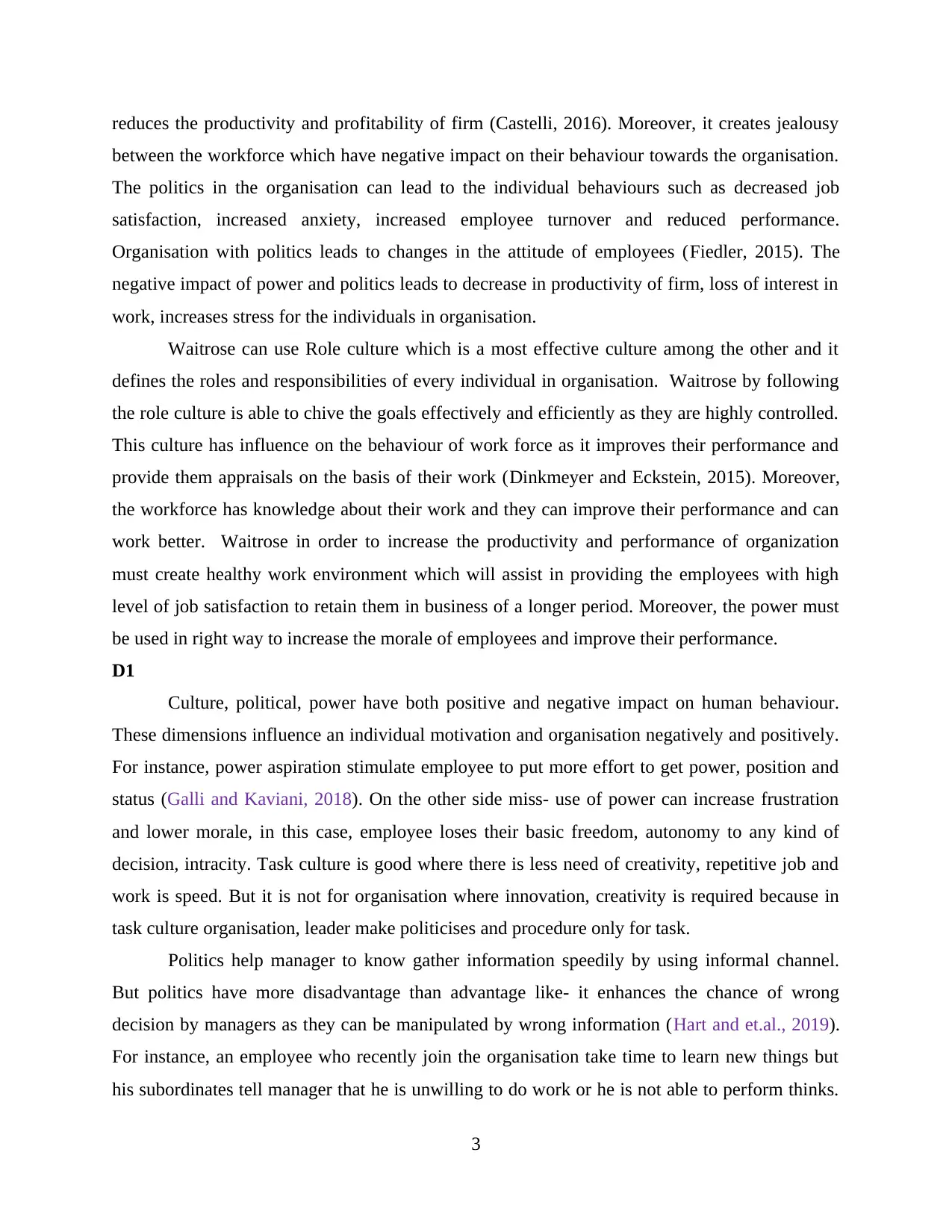
reduces the productivity and profitability of firm (Castelli, 2016). Moreover, it creates jealousy
between the workforce which have negative impact on their behaviour towards the organisation.
The politics in the organisation can lead to the individual behaviours such as decreased job
satisfaction, increased anxiety, increased employee turnover and reduced performance.
Organisation with politics leads to changes in the attitude of employees (Fiedler, 2015). The
negative impact of power and politics leads to decrease in productivity of firm, loss of interest in
work, increases stress for the individuals in organisation.
Waitrose can use Role culture which is a most effective culture among the other and it
defines the roles and responsibilities of every individual in organisation. Waitrose by following
the role culture is able to chive the goals effectively and efficiently as they are highly controlled.
This culture has influence on the behaviour of work force as it improves their performance and
provide them appraisals on the basis of their work (Dinkmeyer and Eckstein, 2015). Moreover,
the workforce has knowledge about their work and they can improve their performance and can
work better. Waitrose in order to increase the productivity and performance of organization
must create healthy work environment which will assist in providing the employees with high
level of job satisfaction to retain them in business of a longer period. Moreover, the power must
be used in right way to increase the morale of employees and improve their performance.
D1
Culture, political, power have both positive and negative impact on human behaviour.
These dimensions influence an individual motivation and organisation negatively and positively.
For instance, power aspiration stimulate employee to put more effort to get power, position and
status (Galli and Kaviani, 2018). On the other side miss- use of power can increase frustration
and lower morale, in this case, employee loses their basic freedom, autonomy to any kind of
decision, intracity. Task culture is good where there is less need of creativity, repetitive job and
work is speed. But it is not for organisation where innovation, creativity is required because in
task culture organisation, leader make politicises and procedure only for task.
Politics help manager to know gather information speedily by using informal channel.
But politics have more disadvantage than advantage like- it enhances the chance of wrong
decision by managers as they can be manipulated by wrong information (Hart and et.al., 2019).
For instance, an employee who recently join the organisation take time to learn new things but
his subordinates tell manager that he is unwilling to do work or he is not able to perform thinks.
3
between the workforce which have negative impact on their behaviour towards the organisation.
The politics in the organisation can lead to the individual behaviours such as decreased job
satisfaction, increased anxiety, increased employee turnover and reduced performance.
Organisation with politics leads to changes in the attitude of employees (Fiedler, 2015). The
negative impact of power and politics leads to decrease in productivity of firm, loss of interest in
work, increases stress for the individuals in organisation.
Waitrose can use Role culture which is a most effective culture among the other and it
defines the roles and responsibilities of every individual in organisation. Waitrose by following
the role culture is able to chive the goals effectively and efficiently as they are highly controlled.
This culture has influence on the behaviour of work force as it improves their performance and
provide them appraisals on the basis of their work (Dinkmeyer and Eckstein, 2015). Moreover,
the workforce has knowledge about their work and they can improve their performance and can
work better. Waitrose in order to increase the productivity and performance of organization
must create healthy work environment which will assist in providing the employees with high
level of job satisfaction to retain them in business of a longer period. Moreover, the power must
be used in right way to increase the morale of employees and improve their performance.
D1
Culture, political, power have both positive and negative impact on human behaviour.
These dimensions influence an individual motivation and organisation negatively and positively.
For instance, power aspiration stimulate employee to put more effort to get power, position and
status (Galli and Kaviani, 2018). On the other side miss- use of power can increase frustration
and lower morale, in this case, employee loses their basic freedom, autonomy to any kind of
decision, intracity. Task culture is good where there is less need of creativity, repetitive job and
work is speed. But it is not for organisation where innovation, creativity is required because in
task culture organisation, leader make politicises and procedure only for task.
Politics help manager to know gather information speedily by using informal channel.
But politics have more disadvantage than advantage like- it enhances the chance of wrong
decision by managers as they can be manipulated by wrong information (Hart and et.al., 2019).
For instance, an employee who recently join the organisation take time to learn new things but
his subordinates tell manager that he is unwilling to do work or he is not able to perform thinks.
3
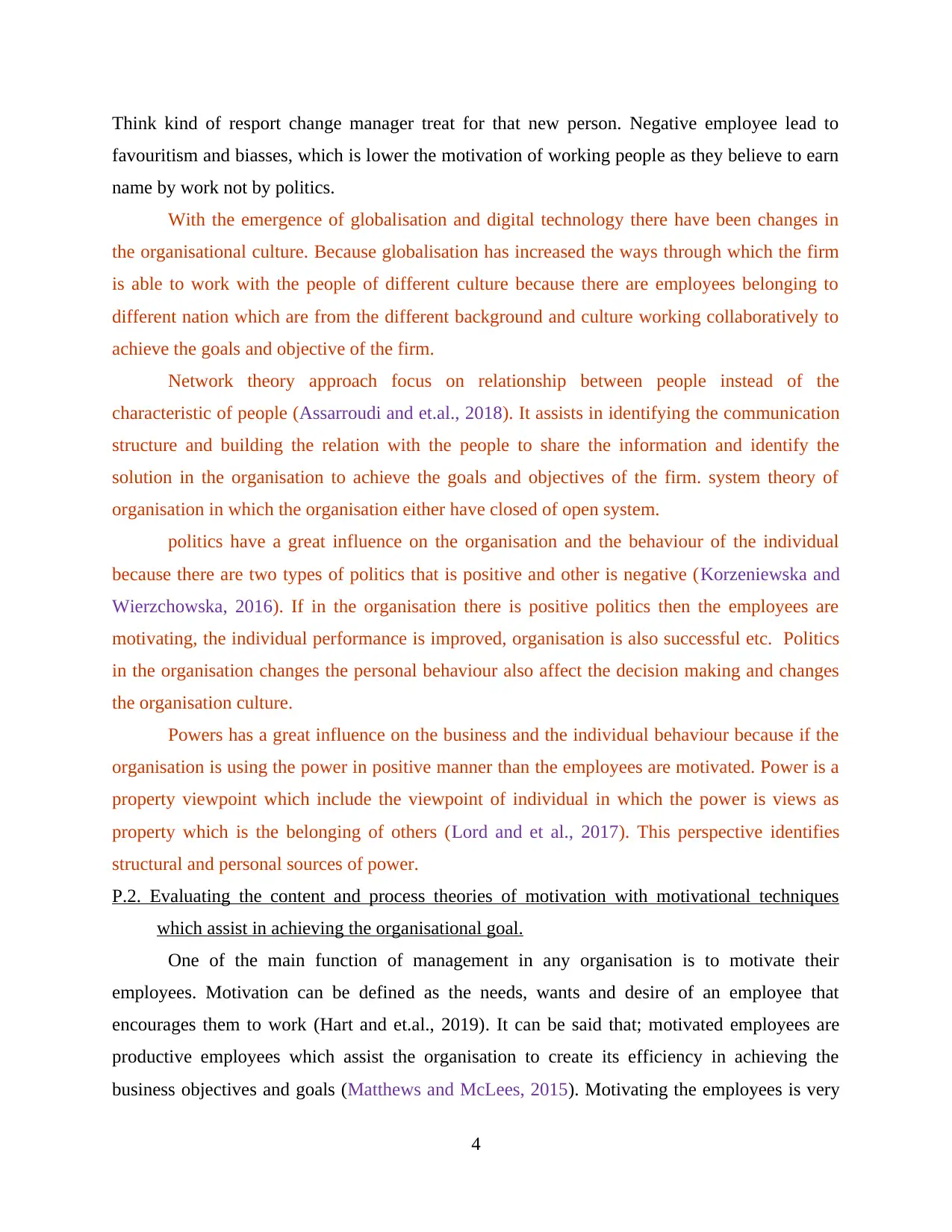
Think kind of resport change manager treat for that new person. Negative employee lead to
favouritism and biasses, which is lower the motivation of working people as they believe to earn
name by work not by politics.
With the emergence of globalisation and digital technology there have been changes in
the organisational culture. Because globalisation has increased the ways through which the firm
is able to work with the people of different culture because there are employees belonging to
different nation which are from the different background and culture working collaboratively to
achieve the goals and objective of the firm.
Network theory approach focus on relationship between people instead of the
characteristic of people (Assarroudi and et.al., 2018). It assists in identifying the communication
structure and building the relation with the people to share the information and identify the
solution in the organisation to achieve the goals and objectives of the firm. system theory of
organisation in which the organisation either have closed of open system.
politics have a great influence on the organisation and the behaviour of the individual
because there are two types of politics that is positive and other is negative (Korzeniewska and
Wierzchowska, 2016). If in the organisation there is positive politics then the employees are
motivating, the individual performance is improved, organisation is also successful etc. Politics
in the organisation changes the personal behaviour also affect the decision making and changes
the organisation culture.
Powers has a great influence on the business and the individual behaviour because if the
organisation is using the power in positive manner than the employees are motivated. Power is a
property viewpoint which include the viewpoint of individual in which the power is views as
property which is the belonging of others (Lord and et al., 2017). This perspective identifies
structural and personal sources of power.
P.2. Evaluating the content and process theories of motivation with motivational techniques
which assist in achieving the organisational goal.
One of the main function of management in any organisation is to motivate their
employees. Motivation can be defined as the needs, wants and desire of an employee that
encourages them to work (Hart and et.al., 2019). It can be said that; motivated employees are
productive employees which assist the organisation to create its efficiency in achieving the
business objectives and goals (Matthews and McLees, 2015). Motivating the employees is very
4
favouritism and biasses, which is lower the motivation of working people as they believe to earn
name by work not by politics.
With the emergence of globalisation and digital technology there have been changes in
the organisational culture. Because globalisation has increased the ways through which the firm
is able to work with the people of different culture because there are employees belonging to
different nation which are from the different background and culture working collaboratively to
achieve the goals and objective of the firm.
Network theory approach focus on relationship between people instead of the
characteristic of people (Assarroudi and et.al., 2018). It assists in identifying the communication
structure and building the relation with the people to share the information and identify the
solution in the organisation to achieve the goals and objectives of the firm. system theory of
organisation in which the organisation either have closed of open system.
politics have a great influence on the organisation and the behaviour of the individual
because there are two types of politics that is positive and other is negative (Korzeniewska and
Wierzchowska, 2016). If in the organisation there is positive politics then the employees are
motivating, the individual performance is improved, organisation is also successful etc. Politics
in the organisation changes the personal behaviour also affect the decision making and changes
the organisation culture.
Powers has a great influence on the business and the individual behaviour because if the
organisation is using the power in positive manner than the employees are motivated. Power is a
property viewpoint which include the viewpoint of individual in which the power is views as
property which is the belonging of others (Lord and et al., 2017). This perspective identifies
structural and personal sources of power.
P.2. Evaluating the content and process theories of motivation with motivational techniques
which assist in achieving the organisational goal.
One of the main function of management in any organisation is to motivate their
employees. Motivation can be defined as the needs, wants and desire of an employee that
encourages them to work (Hart and et.al., 2019). It can be said that; motivated employees are
productive employees which assist the organisation to create its efficiency in achieving the
business objectives and goals (Matthews and McLees, 2015). Motivating the employees is very
4
⊘ This is a preview!⊘
Do you want full access?
Subscribe today to unlock all pages.

Trusted by 1+ million students worldwide
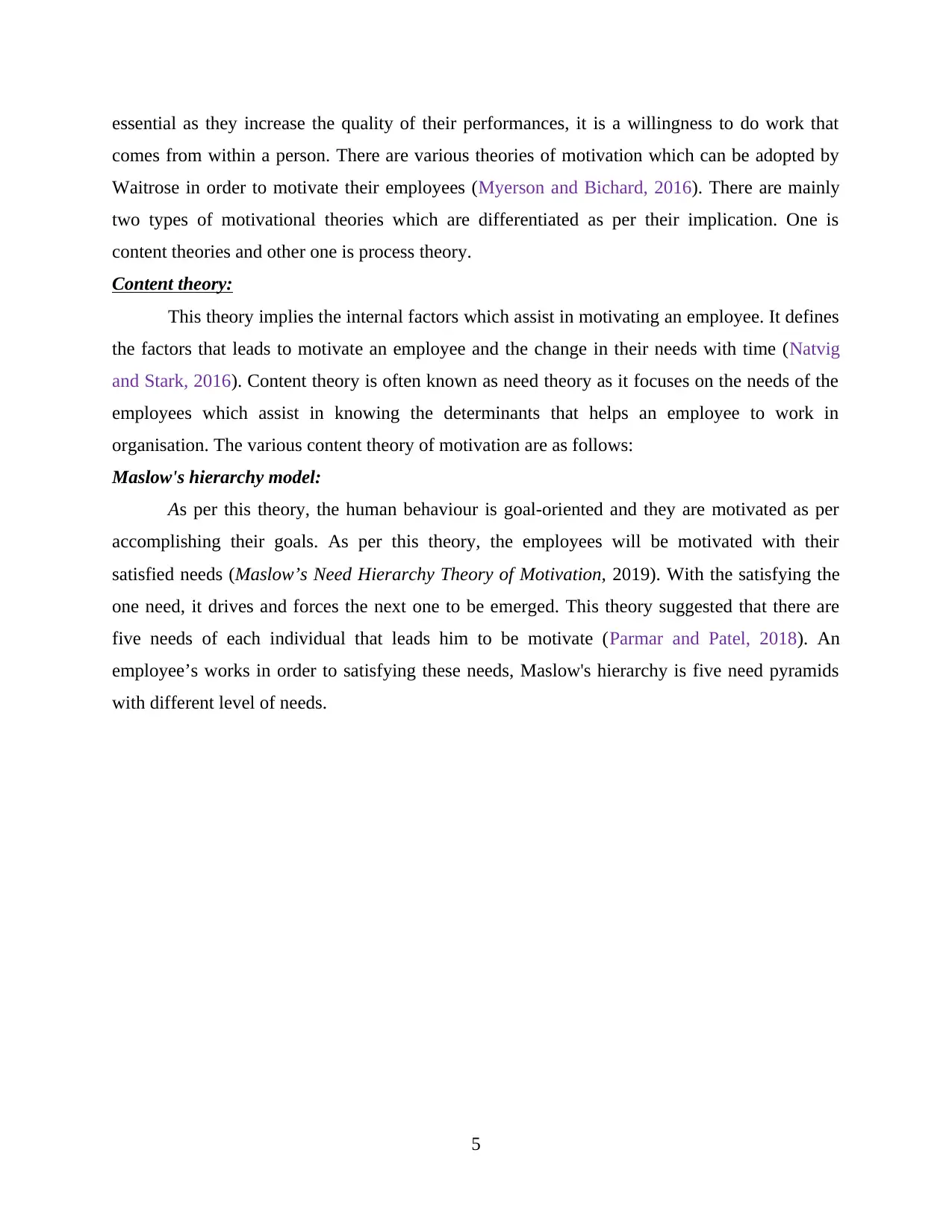
essential as they increase the quality of their performances, it is a willingness to do work that
comes from within a person. There are various theories of motivation which can be adopted by
Waitrose in order to motivate their employees (Myerson and Bichard, 2016). There are mainly
two types of motivational theories which are differentiated as per their implication. One is
content theories and other one is process theory.
Content theory:
This theory implies the internal factors which assist in motivating an employee. It defines
the factors that leads to motivate an employee and the change in their needs with time (Natvig
and Stark, 2016). Content theory is often known as need theory as it focuses on the needs of the
employees which assist in knowing the determinants that helps an employee to work in
organisation. The various content theory of motivation are as follows:
Maslow's hierarchy model:
As per this theory, the human behaviour is goal-oriented and they are motivated as per
accomplishing their goals. As per this theory, the employees will be motivated with their
satisfied needs (Maslow’s Need Hierarchy Theory of Motivation, 2019). With the satisfying the
one need, it drives and forces the next one to be emerged. This theory suggested that there are
five needs of each individual that leads him to be motivate (Parmar and Patel, 2018). An
employee’s works in order to satisfying these needs, Maslow's hierarchy is five need pyramids
with different level of needs.
5
comes from within a person. There are various theories of motivation which can be adopted by
Waitrose in order to motivate their employees (Myerson and Bichard, 2016). There are mainly
two types of motivational theories which are differentiated as per their implication. One is
content theories and other one is process theory.
Content theory:
This theory implies the internal factors which assist in motivating an employee. It defines
the factors that leads to motivate an employee and the change in their needs with time (Natvig
and Stark, 2016). Content theory is often known as need theory as it focuses on the needs of the
employees which assist in knowing the determinants that helps an employee to work in
organisation. The various content theory of motivation are as follows:
Maslow's hierarchy model:
As per this theory, the human behaviour is goal-oriented and they are motivated as per
accomplishing their goals. As per this theory, the employees will be motivated with their
satisfied needs (Maslow’s Need Hierarchy Theory of Motivation, 2019). With the satisfying the
one need, it drives and forces the next one to be emerged. This theory suggested that there are
five needs of each individual that leads him to be motivate (Parmar and Patel, 2018). An
employee’s works in order to satisfying these needs, Maslow's hierarchy is five need pyramids
with different level of needs.
5
Paraphrase This Document
Need a fresh take? Get an instant paraphrase of this document with our AI Paraphraser
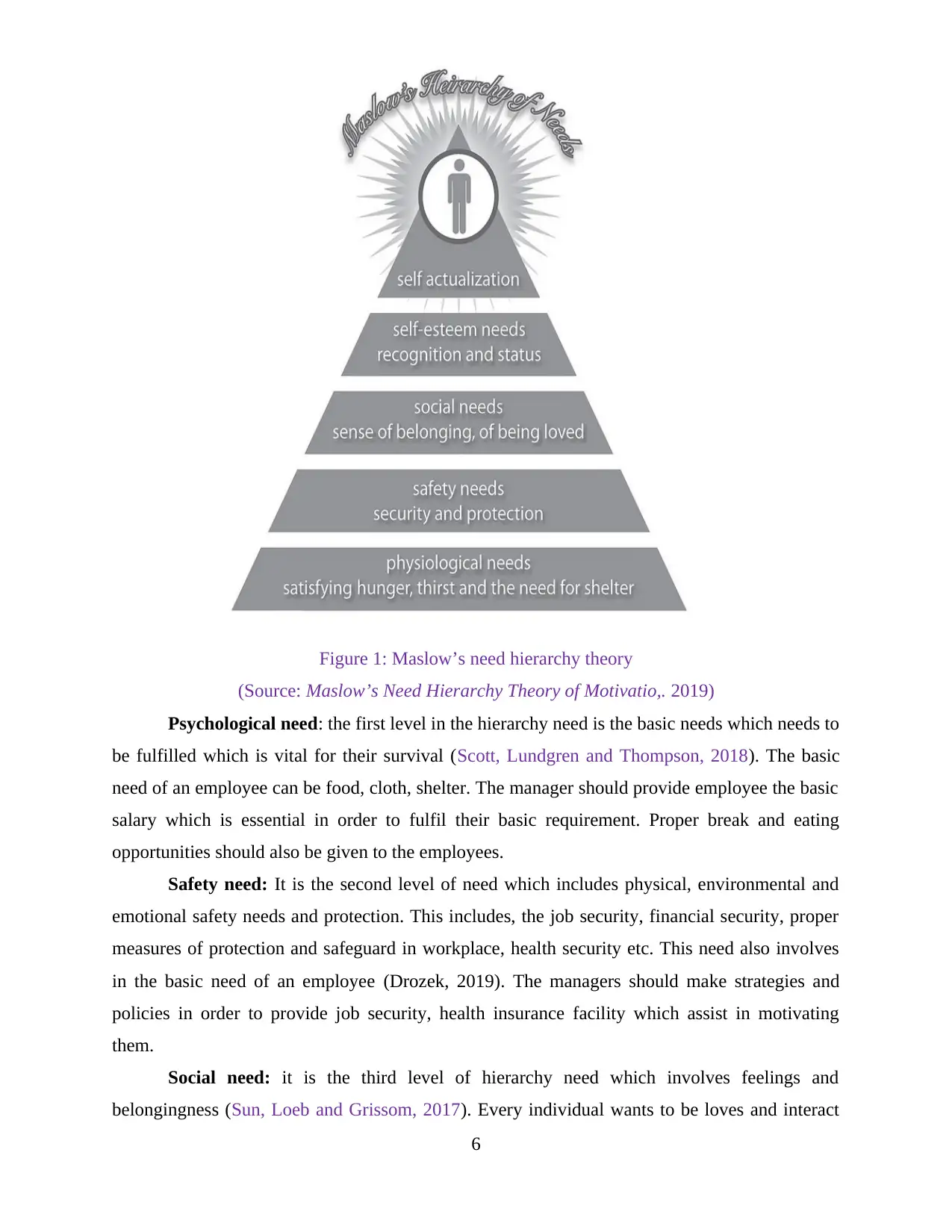
Figure 1: Maslow’s need hierarchy theory
(Source: Maslow’s Need Hierarchy Theory of Motivatio,. 2019)
Psychological need: the first level in the hierarchy need is the basic needs which needs to
be fulfilled which is vital for their survival (Scott, Lundgren and Thompson, 2018). The basic
need of an employee can be food, cloth, shelter. The manager should provide employee the basic
salary which is essential in order to fulfil their basic requirement. Proper break and eating
opportunities should also be given to the employees.
Safety need: It is the second level of need which includes physical, environmental and
emotional safety needs and protection. This includes, the job security, financial security, proper
measures of protection and safeguard in workplace, health security etc. This need also involves
in the basic need of an employee (Drozek, 2019). The managers should make strategies and
policies in order to provide job security, health insurance facility which assist in motivating
them.
Social need: it is the third level of hierarchy need which involves feelings and
belongingness (Sun, Loeb and Grissom, 2017). Every individual wants to be loves and interact
6
(Source: Maslow’s Need Hierarchy Theory of Motivatio,. 2019)
Psychological need: the first level in the hierarchy need is the basic needs which needs to
be fulfilled which is vital for their survival (Scott, Lundgren and Thompson, 2018). The basic
need of an employee can be food, cloth, shelter. The manager should provide employee the basic
salary which is essential in order to fulfil their basic requirement. Proper break and eating
opportunities should also be given to the employees.
Safety need: It is the second level of need which includes physical, environmental and
emotional safety needs and protection. This includes, the job security, financial security, proper
measures of protection and safeguard in workplace, health security etc. This need also involves
in the basic need of an employee (Drozek, 2019). The managers should make strategies and
policies in order to provide job security, health insurance facility which assist in motivating
them.
Social need: it is the third level of hierarchy need which involves feelings and
belongingness (Sun, Loeb and Grissom, 2017). Every individual wants to be loves and interact
6
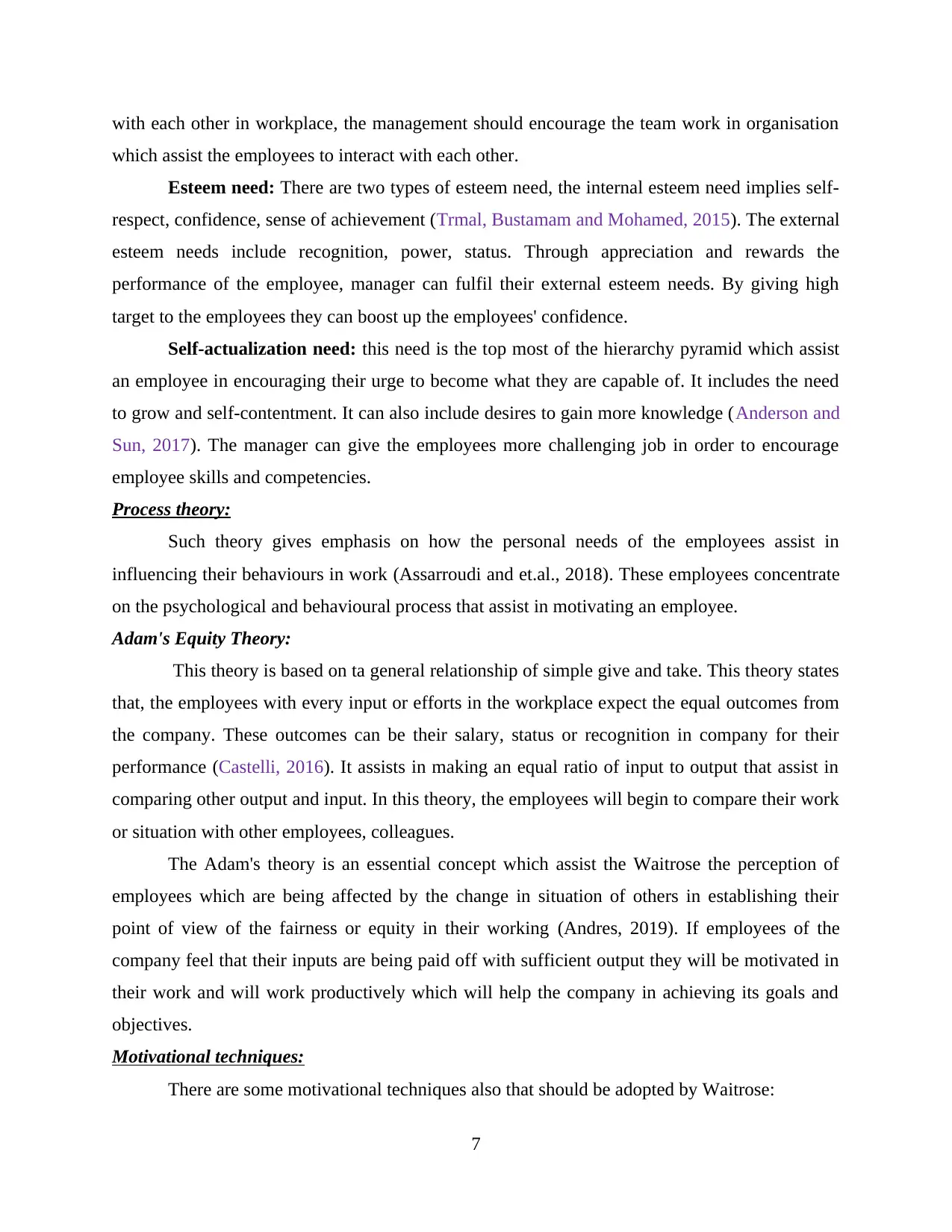
with each other in workplace, the management should encourage the team work in organisation
which assist the employees to interact with each other.
Esteem need: There are two types of esteem need, the internal esteem need implies self-
respect, confidence, sense of achievement (Trmal, Bustamam and Mohamed, 2015). The external
esteem needs include recognition, power, status. Through appreciation and rewards the
performance of the employee, manager can fulfil their external esteem needs. By giving high
target to the employees they can boost up the employees' confidence.
Self-actualization need: this need is the top most of the hierarchy pyramid which assist
an employee in encouraging their urge to become what they are capable of. It includes the need
to grow and self-contentment. It can also include desires to gain more knowledge (Anderson and
Sun, 2017). The manager can give the employees more challenging job in order to encourage
employee skills and competencies.
Process theory:
Such theory gives emphasis on how the personal needs of the employees assist in
influencing their behaviours in work (Assarroudi and et.al., 2018). These employees concentrate
on the psychological and behavioural process that assist in motivating an employee.
Adam's Equity Theory:
This theory is based on ta general relationship of simple give and take. This theory states
that, the employees with every input or efforts in the workplace expect the equal outcomes from
the company. These outcomes can be their salary, status or recognition in company for their
performance (Castelli, 2016). It assists in making an equal ratio of input to output that assist in
comparing other output and input. In this theory, the employees will begin to compare their work
or situation with other employees, colleagues.
The Adam's theory is an essential concept which assist the Waitrose the perception of
employees which are being affected by the change in situation of others in establishing their
point of view of the fairness or equity in their working (Andres, 2019). If employees of the
company feel that their inputs are being paid off with sufficient output they will be motivated in
their work and will work productively which will help the company in achieving its goals and
objectives.
Motivational techniques:
There are some motivational techniques also that should be adopted by Waitrose:
7
which assist the employees to interact with each other.
Esteem need: There are two types of esteem need, the internal esteem need implies self-
respect, confidence, sense of achievement (Trmal, Bustamam and Mohamed, 2015). The external
esteem needs include recognition, power, status. Through appreciation and rewards the
performance of the employee, manager can fulfil their external esteem needs. By giving high
target to the employees they can boost up the employees' confidence.
Self-actualization need: this need is the top most of the hierarchy pyramid which assist
an employee in encouraging their urge to become what they are capable of. It includes the need
to grow and self-contentment. It can also include desires to gain more knowledge (Anderson and
Sun, 2017). The manager can give the employees more challenging job in order to encourage
employee skills and competencies.
Process theory:
Such theory gives emphasis on how the personal needs of the employees assist in
influencing their behaviours in work (Assarroudi and et.al., 2018). These employees concentrate
on the psychological and behavioural process that assist in motivating an employee.
Adam's Equity Theory:
This theory is based on ta general relationship of simple give and take. This theory states
that, the employees with every input or efforts in the workplace expect the equal outcomes from
the company. These outcomes can be their salary, status or recognition in company for their
performance (Castelli, 2016). It assists in making an equal ratio of input to output that assist in
comparing other output and input. In this theory, the employees will begin to compare their work
or situation with other employees, colleagues.
The Adam's theory is an essential concept which assist the Waitrose the perception of
employees which are being affected by the change in situation of others in establishing their
point of view of the fairness or equity in their working (Andres, 2019). If employees of the
company feel that their inputs are being paid off with sufficient output they will be motivated in
their work and will work productively which will help the company in achieving its goals and
objectives.
Motivational techniques:
There are some motivational techniques also that should be adopted by Waitrose:
7
⊘ This is a preview!⊘
Do you want full access?
Subscribe today to unlock all pages.

Trusted by 1+ million students worldwide
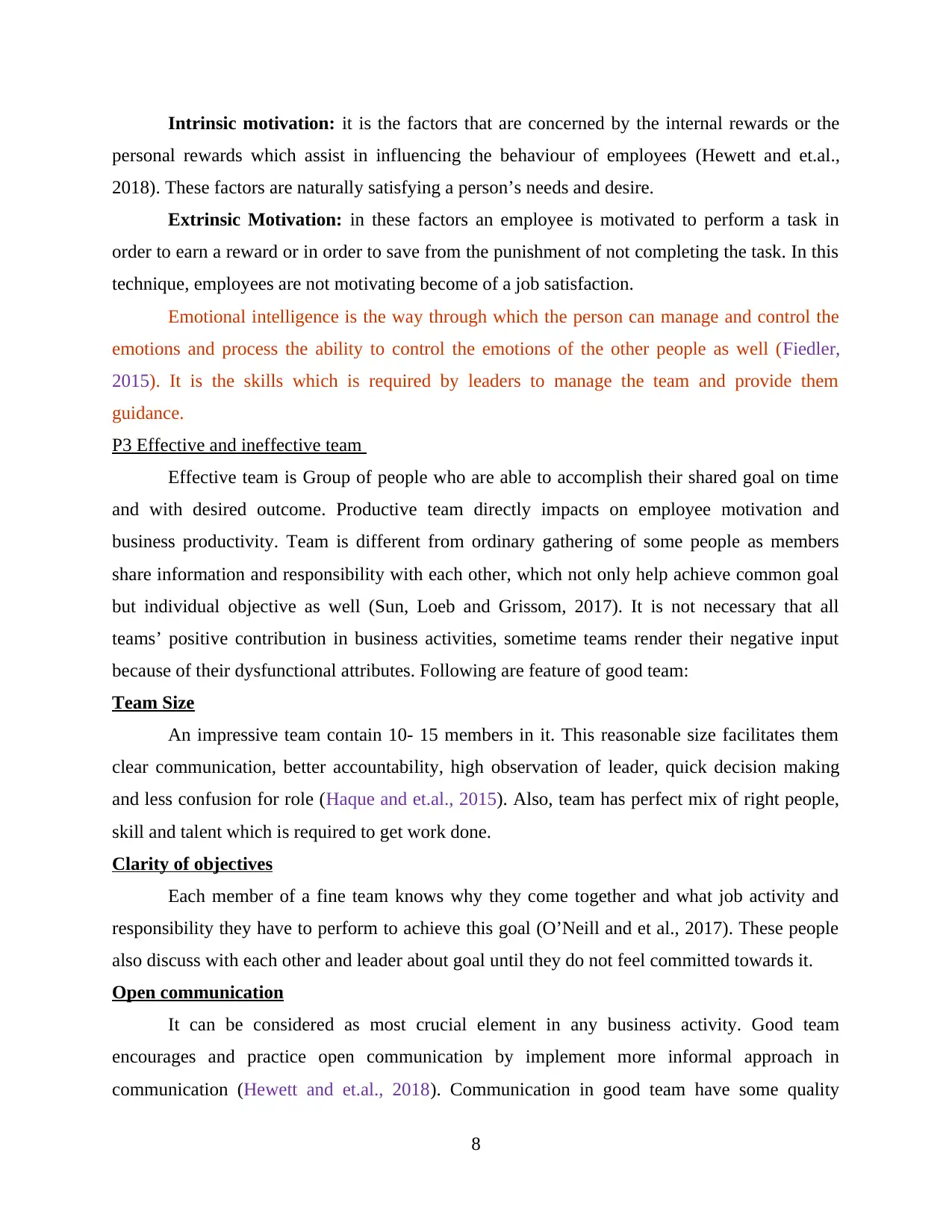
Intrinsic motivation: it is the factors that are concerned by the internal rewards or the
personal rewards which assist in influencing the behaviour of employees (Hewett and et.al.,
2018). These factors are naturally satisfying a person’s needs and desire.
Extrinsic Motivation: in these factors an employee is motivated to perform a task in
order to earn a reward or in order to save from the punishment of not completing the task. In this
technique, employees are not motivating become of a job satisfaction.
Emotional intelligence is the way through which the person can manage and control the
emotions and process the ability to control the emotions of the other people as well (Fiedler,
2015). It is the skills which is required by leaders to manage the team and provide them
guidance.
P3 Effective and ineffective team
Effective team is Group of people who are able to accomplish their shared goal on time
and with desired outcome. Productive team directly impacts on employee motivation and
business productivity. Team is different from ordinary gathering of some people as members
share information and responsibility with each other, which not only help achieve common goal
but individual objective as well (Sun, Loeb and Grissom, 2017). It is not necessary that all
teams’ positive contribution in business activities, sometime teams render their negative input
because of their dysfunctional attributes. Following are feature of good team:
Team Size
An impressive team contain 10- 15 members in it. This reasonable size facilitates them
clear communication, better accountability, high observation of leader, quick decision making
and less confusion for role (Haque and et.al., 2015). Also, team has perfect mix of right people,
skill and talent which is required to get work done.
Clarity of objectives
Each member of a fine team knows why they come together and what job activity and
responsibility they have to perform to achieve this goal (O’Neill and et al., 2017). These people
also discuss with each other and leader about goal until they do not feel committed towards it.
Open communication
It can be considered as most crucial element in any business activity. Good team
encourages and practice open communication by implement more informal approach in
communication (Hewett and et.al., 2018). Communication in good team have some quality
8
personal rewards which assist in influencing the behaviour of employees (Hewett and et.al.,
2018). These factors are naturally satisfying a person’s needs and desire.
Extrinsic Motivation: in these factors an employee is motivated to perform a task in
order to earn a reward or in order to save from the punishment of not completing the task. In this
technique, employees are not motivating become of a job satisfaction.
Emotional intelligence is the way through which the person can manage and control the
emotions and process the ability to control the emotions of the other people as well (Fiedler,
2015). It is the skills which is required by leaders to manage the team and provide them
guidance.
P3 Effective and ineffective team
Effective team is Group of people who are able to accomplish their shared goal on time
and with desired outcome. Productive team directly impacts on employee motivation and
business productivity. Team is different from ordinary gathering of some people as members
share information and responsibility with each other, which not only help achieve common goal
but individual objective as well (Sun, Loeb and Grissom, 2017). It is not necessary that all
teams’ positive contribution in business activities, sometime teams render their negative input
because of their dysfunctional attributes. Following are feature of good team:
Team Size
An impressive team contain 10- 15 members in it. This reasonable size facilitates them
clear communication, better accountability, high observation of leader, quick decision making
and less confusion for role (Haque and et.al., 2015). Also, team has perfect mix of right people,
skill and talent which is required to get work done.
Clarity of objectives
Each member of a fine team knows why they come together and what job activity and
responsibility they have to perform to achieve this goal (O’Neill and et al., 2017). These people
also discuss with each other and leader about goal until they do not feel committed towards it.
Open communication
It can be considered as most crucial element in any business activity. Good team
encourages and practice open communication by implement more informal approach in
communication (Hewett and et.al., 2018). Communication in good team have some quality
8
Paraphrase This Document
Need a fresh take? Get an instant paraphrase of this document with our AI Paraphraser
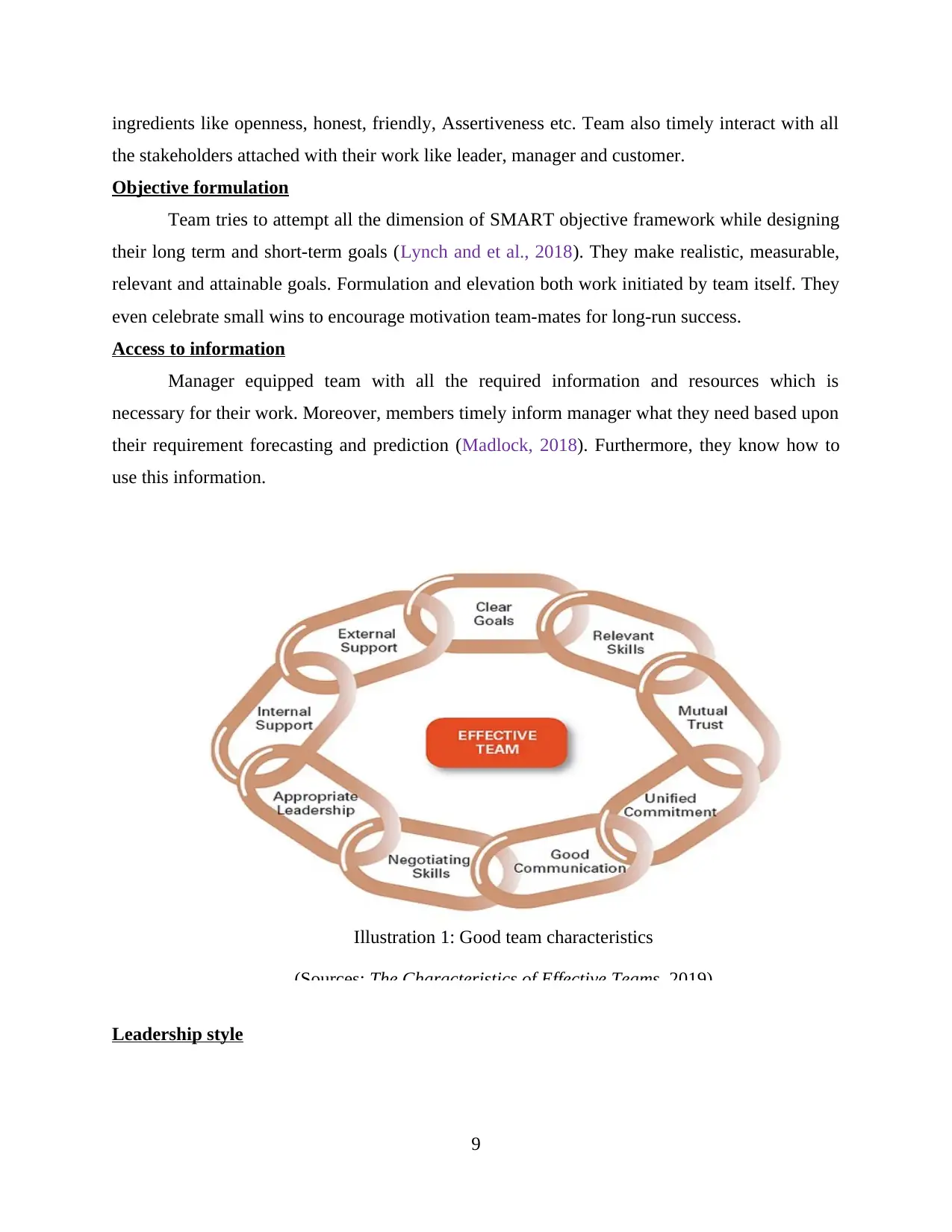
ingredients like openness, honest, friendly, Assertiveness etc. Team also timely interact with all
the stakeholders attached with their work like leader, manager and customer.
Objective formulation
Team tries to attempt all the dimension of SMART objective framework while designing
their long term and short-term goals (Lynch and et al., 2018). They make realistic, measurable,
relevant and attainable goals. Formulation and elevation both work initiated by team itself. They
even celebrate small wins to encourage motivation team-mates for long-run success.
Access to information
Manager equipped team with all the required information and resources which is
necessary for their work. Moreover, members timely inform manager what they need based upon
their requirement forecasting and prediction (Madlock, 2018). Furthermore, they know how to
use this information.
Leadership style
9
Illustration 1: Good team characteristics
(Sources: The Characteristics of Effective Teams, 2019)
the stakeholders attached with their work like leader, manager and customer.
Objective formulation
Team tries to attempt all the dimension of SMART objective framework while designing
their long term and short-term goals (Lynch and et al., 2018). They make realistic, measurable,
relevant and attainable goals. Formulation and elevation both work initiated by team itself. They
even celebrate small wins to encourage motivation team-mates for long-run success.
Access to information
Manager equipped team with all the required information and resources which is
necessary for their work. Moreover, members timely inform manager what they need based upon
their requirement forecasting and prediction (Madlock, 2018). Furthermore, they know how to
use this information.
Leadership style
9
Illustration 1: Good team characteristics
(Sources: The Characteristics of Effective Teams, 2019)
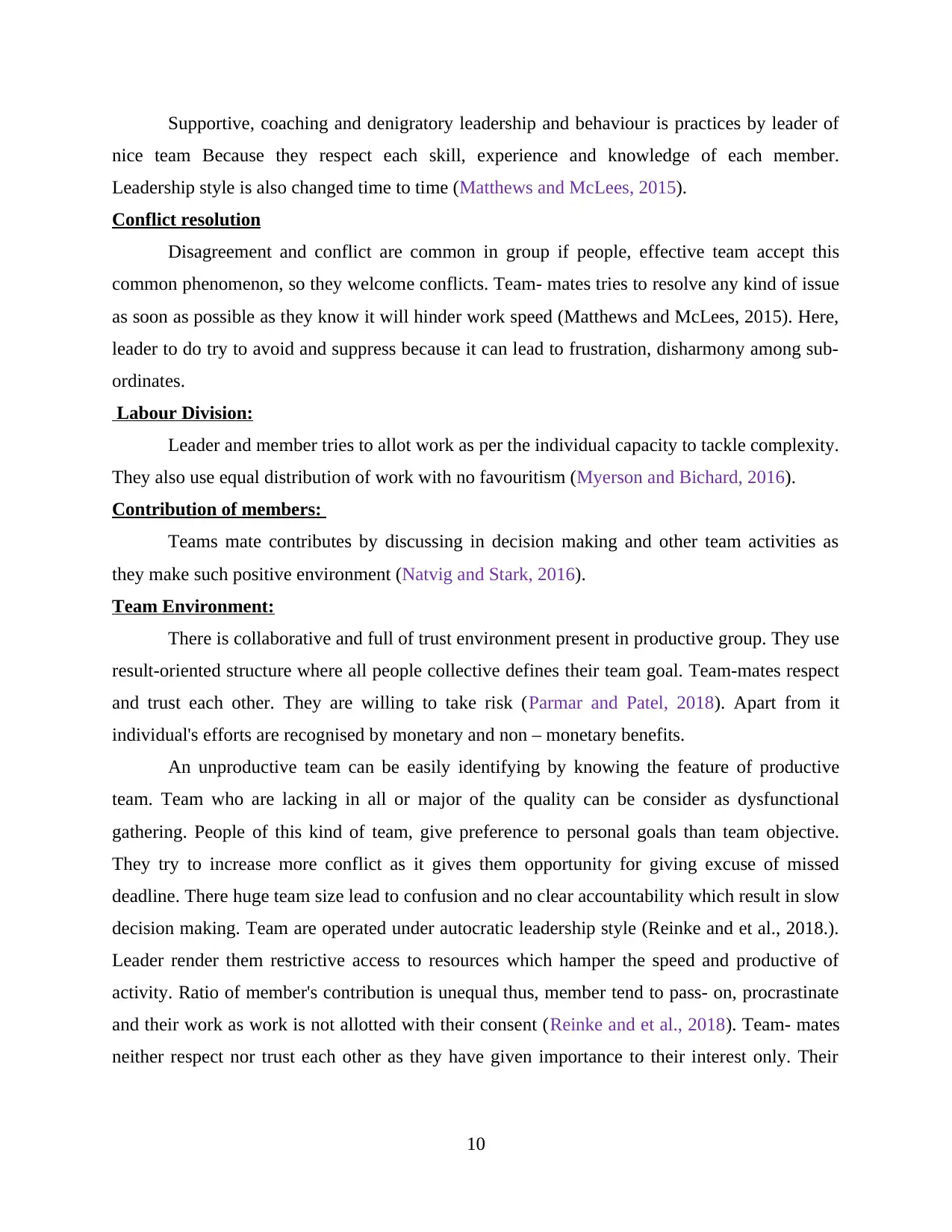
Supportive, coaching and denigratory leadership and behaviour is practices by leader of
nice team Because they respect each skill, experience and knowledge of each member.
Leadership style is also changed time to time (Matthews and McLees, 2015).
Conflict resolution
Disagreement and conflict are common in group if people, effective team accept this
common phenomenon, so they welcome conflicts. Team- mates tries to resolve any kind of issue
as soon as possible as they know it will hinder work speed (Matthews and McLees, 2015). Here,
leader to do try to avoid and suppress because it can lead to frustration, disharmony among sub-
ordinates.
Labour Division:
Leader and member tries to allot work as per the individual capacity to tackle complexity.
They also use equal distribution of work with no favouritism (Myerson and Bichard, 2016).
Contribution of members:
Teams mate contributes by discussing in decision making and other team activities as
they make such positive environment (Natvig and Stark, 2016).
Team Environment:
There is collaborative and full of trust environment present in productive group. They use
result-oriented structure where all people collective defines their team goal. Team-mates respect
and trust each other. They are willing to take risk (Parmar and Patel, 2018). Apart from it
individual's efforts are recognised by monetary and non – monetary benefits.
An unproductive team can be easily identifying by knowing the feature of productive
team. Team who are lacking in all or major of the quality can be consider as dysfunctional
gathering. People of this kind of team, give preference to personal goals than team objective.
They try to increase more conflict as it gives them opportunity for giving excuse of missed
deadline. There huge team size lead to confusion and no clear accountability which result in slow
decision making. Team are operated under autocratic leadership style (Reinke and et al., 2018.).
Leader render them restrictive access to resources which hamper the speed and productive of
activity. Ratio of member's contribution is unequal thus, member tend to pass- on, procrastinate
and their work as work is not allotted with their consent (Reinke and et al., 2018). Team- mates
neither respect nor trust each other as they have given importance to their interest only. Their
10
nice team Because they respect each skill, experience and knowledge of each member.
Leadership style is also changed time to time (Matthews and McLees, 2015).
Conflict resolution
Disagreement and conflict are common in group if people, effective team accept this
common phenomenon, so they welcome conflicts. Team- mates tries to resolve any kind of issue
as soon as possible as they know it will hinder work speed (Matthews and McLees, 2015). Here,
leader to do try to avoid and suppress because it can lead to frustration, disharmony among sub-
ordinates.
Labour Division:
Leader and member tries to allot work as per the individual capacity to tackle complexity.
They also use equal distribution of work with no favouritism (Myerson and Bichard, 2016).
Contribution of members:
Teams mate contributes by discussing in decision making and other team activities as
they make such positive environment (Natvig and Stark, 2016).
Team Environment:
There is collaborative and full of trust environment present in productive group. They use
result-oriented structure where all people collective defines their team goal. Team-mates respect
and trust each other. They are willing to take risk (Parmar and Patel, 2018). Apart from it
individual's efforts are recognised by monetary and non – monetary benefits.
An unproductive team can be easily identifying by knowing the feature of productive
team. Team who are lacking in all or major of the quality can be consider as dysfunctional
gathering. People of this kind of team, give preference to personal goals than team objective.
They try to increase more conflict as it gives them opportunity for giving excuse of missed
deadline. There huge team size lead to confusion and no clear accountability which result in slow
decision making. Team are operated under autocratic leadership style (Reinke and et al., 2018.).
Leader render them restrictive access to resources which hamper the speed and productive of
activity. Ratio of member's contribution is unequal thus, member tend to pass- on, procrastinate
and their work as work is not allotted with their consent (Reinke and et al., 2018). Team- mates
neither respect nor trust each other as they have given importance to their interest only. Their
10
⊘ This is a preview!⊘
Do you want full access?
Subscribe today to unlock all pages.

Trusted by 1+ million students worldwide
1 out of 27
Related Documents
Your All-in-One AI-Powered Toolkit for Academic Success.
+13062052269
info@desklib.com
Available 24*7 on WhatsApp / Email
![[object Object]](/_next/static/media/star-bottom.7253800d.svg)
Unlock your academic potential
Copyright © 2020–2025 A2Z Services. All Rights Reserved. Developed and managed by ZUCOL.



